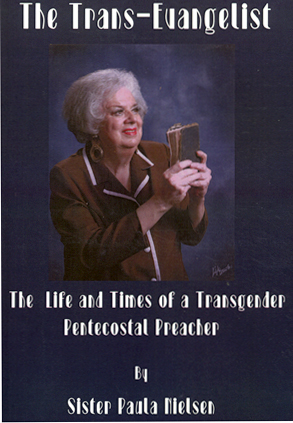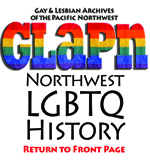The Trans-Evangelist, the Life and Times of a Transgender Pentecostal Preacher,
by Sister Paula Nielsen. One Spirit Press, Portland, OR, 2014, 315 pages
Reviewed by Robin Will
Larry Nielsen was born in Portland, Oregon, in 1938. He grew up to be a tall, effeminate boy who could sing, and who fantasized about being a minister’s wife.
 He didn’t become a minister’s wife. But eventually, as a transgender woman, he became a Pentecostal preacher. The person who first said, “you can’t make this stuff up,” might have had this narrative in mind: the story of how the gay boy from Gresham Union High School, class of 1956, became Sister Paula Nielsen, a cable-access television evangelist with a worldwide following.
He didn’t become a minister’s wife. But eventually, as a transgender woman, he became a Pentecostal preacher. The person who first said, “you can’t make this stuff up,” might have had this narrative in mind: the story of how the gay boy from Gresham Union High School, class of 1956, became Sister Paula Nielsen, a cable-access television evangelist with a worldwide following.
The story’s timeline contains three more-or-less distinct segments.
First, there’s the story of Larry as a child and a young gay man (because that’s how he identified at first). In 1956, fresh out of high school, Larry got a job delivering typewriter ribbons and carbon paper in Portland, and moved into a rented room. There were two gay bars in town, neither of which he could visit as an 18-year-old, but he learned there were places to cruise for sex. He also learned that propositioning the wrong guy could net a visit and a warrantless search by the police, and that splitting a quart of beer with an underage kid could capture the attention of the OLCC (Oregon Liquor Control Commission).
In about 1960, Larry moved to California for a dozen years, first in San Francisco and then in Los Angeles. On May 1, 1963, while moving from one apartment to another, he left all of his male clothing behind, and lived as a woman ever after. That was 6 years before Stonewall, 10 years before homosexuality came off of the American Psychiatric Association’s list of mental disorders, at a time when the world of transgender/transsexual people was still shadowy. Paula went to work and to church passing as a woman, with no support outside her circle of friends, and no idea when the hammer of rejection might drop.
Finally, in the early 1970s, Paula returned to Portland and made her mark as a writer, entertainer and activist in the LGBTQ community that developed after Stonewall.
But the real story here is how a transgender woman became a Pentecostal evangelist. It’s a story that presents some challenges to a 21st Century LGBTQ reader. We have learned to expect trouble from Christians, and we’re no longer surprised by the consecrated meanness we see from the conservative and charismatic end of the Christian spectrum. If it doesn’t kill them or cast them out, LGBTQ people tend to abandon that kind of background. But not Sister Paula.
Paula appears to have walked a fine line. Larry Nielsen was the kind of kid we might watch these days for suicidal ideation: shuttled among the homes of relatives and divorced parents, scorned by his father, bullied at school for being effeminate. It’s not clear where he ever felt accepted or at ease. However, an experience in a Sunday morning Baptist worship service at age 12 convinced him beyond any doubt that Jesus knew him absolutely, and was his friend, and expected him eventually to preach the gospel. Nothing was ever able to shake that conviction: not abuse, loneliness, rejection, disappointment, nor the teachings of the other churches he attended, either as Larry or as Paula. Larry never joined the Baptists – in fact, the ability to keep Jesus’ love and the requirements of churches in separate compartments may have been the key to Larry’s survival, and it has been central to Paula’s ministry.
The call to preach doesn’t necessarily guarantee that anyone will listen, but Paula found an audience, or maybe the audience found Paula. Over the years, there have been many LGBTQ folks – and many others, as well – who needed to know that Jesus loved them; they needed to hear it in Pentecostal language; and, apparently, they needed to hear it from Paula. She achieved worldwide fame as the trans-evangelist on cable access TV, and though age and economics have slowed her down, she continues to be active in the community into her 77th year.
This book is worth reading for its look at America in the 1940s and 1950s, when there was a Youth for Christ chapter in every high school, and vacation Bible school every summer, and nobody particularly questioned the notion that Christian morality should be law. It’s a worthwhile look at the Pentecostal subculture in general, for those who were never exposed to it. It’s just as worthwhile for its look at the life of a transgender child who was never, ever going to fit inside of that morality or the social norms that prevailed. It’s worthwhile to see how that kid survived, and to understand how he experienced the growth of the LGBTQ movement on the West Coast. And it’s worth reading about the 30th reunion of the Gresham Union High School Class of 1956, which Paula attended in full red-hot-mama drag, when she started believing that she really could be an evangelist, and fulfill that call to preach the gospel.
P.O. Box 3646 • Portland, OR 97208-3646 • info@glapn.or
Copyright © 2015, Gay & Lesbian Archives of the Pacific Northwest

